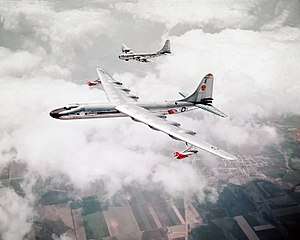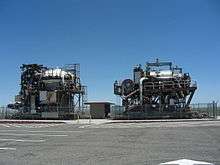Nuclear-powered aircraft
A nuclear-powered aircraft is a concept for an aircraft intended to be powered by nuclear energy. The intention was to produce a jet engine that would heat compressed air with heat from fission, instead of heat from burning fuel. During the Cold War, the United States and Soviet Union researched nuclear-powered bomber aircraft, the greater endurance of which could enhance nuclear deterrence, but neither country created any such operational aircraft.[1]

One inadequately solved design problem was the need for heavy shielding to protect the crew and those on the ground from acute radiation syndrome; other potential problems included dealing with crashes.[2]
Some missile designs included nuclear powered supersonic cruise missiles.
However, the advent of ICBMs and nuclear submarines in the 1960s greatly diminished the strategic advantage of such aircraft, and respective projects were cancelled; the inherent danger of the technology has prevented its civilian use.
U.S. programs
NEPA and ANP
In May 1946, the United States Army Air Forces started the Nuclear Energy for the Propulsion of Aircraft (NEPA) project, which conducted studies until the Aircraft Nuclear Propulsion (ANP) program replaced NEPA in 1951. The ANP program included provisions for studying two different types of nuclear-powered jet engines: General Electric's Direct Air Cycle and Pratt & Whitney's Indirect Air Cycle. ANP planned for Convair to modify two B-36s under the MX-1589 project. One of the B-36s, the NB-36H, was to be used for studying shielding requirements for an airborne reactor, while the other was to be the X-6; however, the program was cancelled before the X-6 was completed.
The first operation of a nuclear aircraft engine occurred on January 31, 1956 using a modified General Electric J47 turbojet engine.[3] The Aircraft Nuclear Propulsion program was terminated by President Kennedy after the his annual budget message to Congress in 1961.
The Oak Ridge National Laboratory researched and developed nuclear aircraft engines. Two shielded reactors powered two General Electric J87 turbojet engines to nearly full thrust. Two experimental reactors, HTRE-2 with its turbojet engines intact, and HTRE-3 with its engines removed, are at the EBR-1 facility south of the Idaho National Laboratory.

The U.S. designed these engines for use in a new, specially-designed nuclear bomber, the WS-125. Although Eisenhower eventually terminated it by cutting NEPA and telling Congress that the program was not urgent, he backed a small program for developing high temperature materials and high performance reactors; that program was terminated early in the Kennedy administration.
Project Pluto
In 1957, the Air Force and the U.S. Atomic Energy Commission contracted with the Lawrence Radiation Laboratory to study the feasibility of applying heat from nuclear reactors to ramjet engines. This research became known as Project Pluto. This program was to provide engines for an unmanned cruise missile, called SLAM, for Supersonic Low Altitude Missile. The program succeeded in producing two test engines, which were operated on the ground. On May 14, 1961, the world's first nuclear ramjet engine, "Tory-IIA," mounted on a railroad car, roared to life for just a few seconds. On July 1, 1964, seven years and six months after it was born, "Project Pluto" was cancelled.
Airships
There were several studies and proposals for nuclear powered airships, starting with 1954 study by F.W. Locke Jr for US Navy.[5] In 1957 Edwin J. Kirschner published the book The Zeppelin in the Atomic Age,[6] which promoted the use of atomic airships. In 1959 Goodyear presented a plan for nuclear powered airship for both military and commercial use. Several other proposals and papers were published during the next decades.
Soviet programs
Soviet nuclear bomber hoax
The 1 December 1958 issue of Aviation Week included an article, Soviets Flight Testing Nuclear Bomber, that claimed that the Soviets had greatly progressed a nuclear aircraft program:[7] "[a] nuclear-powered bomber is being flight tested in the Soviet Union. Completed about six months ago, this aircraft has been flying in the Moscow area for at least two months. It has been observed both in flight and on the ground by a wide variety of foreign observers from Communist and non-Communist countries." Unlike the US designs of the same era, which were purely experimental, the article noted that "The Soviet aircraft is a prototype of a design to perform a military mission as a continuous airborne alert warning system and missile launching platform." Photographs illustrated the article, along with technical diagrams on the proposed layout; these were so widely seen that one company produced a plastic model aircraft based on the diagrams in the article. An editorial on the topic accompanied the article.[8]
Concerns were soon expressed in Washington that "the Russians were from three to five years ahead of the US in the field of atomic aircraft engines and that they would move even further ahead unless the US pressed forward with its own program".[9] These concerns caused continued but temporary funding of the US's own program.
The aircraft in the photographs was later revealed to be the conventional Myasishchev M-50 Bounder, a medium-range strategic bomber that performed like the USAFs B-58 Hustler. The design was considered a failure, never entered service, and was revealed to the public on Soviet Aviation Day in 1963 at Monino, putting the issue to rest.[10]
Tupolev Tu-119
The Soviet program of nuclear aircraft development resulted in the experimental Tupolev Tu-119, or the Tu-95LAL (Russian: LAL- Летающая Атомная Лаборатория, lit. 'Flying Nuclear Laboratory') which derived from the Tupolev Tu-95 bomber. It had two conventional turboprop engines and two direct-cycle nuclear jet engines, and got around the shielding weight issue by simply not including it. According to a letter from test pilot E.A. Guryenov to Scottish journalist George Kerevan:
"We had all been irradiated, but we ignored it. Of the two crews, only three men survived- a young navigator, a military navigator and me. The first to go, a young technician, took only three years to die".
The aircraft is alleged to have been flown up to 40 times from 1961 to 1969.[11] Several other projects, like the supersonic Tupolev Tu-120[12] reached only the design phase.[13][14]
Russian programs
In February 2018, Russian President Vladimir Putin claimed that Russia had developed a new, nuclear-powered cruise missile with nuclear warhead that can evade air and missile defenses and hit any point on the globe. According to the statements its first flight test occurred in 2017. It was claimed to feature "a small-size super-powerful power plant that can be placed inside the hull of a cruise missile and guarantee a range of flight ten times greater than that of other missiles." The video showed the missile evading defense systems over the Atlantic, flying over Cape Horn and finally north towards Hawaii.[15][16][17][18][19] To date there is no publicly available evidence to verify these statements. The Pentagon is aware of a Russian test of a nuclear-powered cruise missile but the system is still under development and had crashed in the Arctic in 2017.[20][21][22] A RAND Corporation researcher specializing in Russia said "My guess is they're not bluffing, that they've flight-tested this thing. But that's incredible."[23] According to a CSIS fellow, such a nuclear powered missile "has an almost unlimited range -- you could have it flying around for long periods of time before you order it to hit something"[24] Putin's statements and the video showing a concept of the missile in flight suggest that it is not a supersonic ramjet like Project Pluto but a subsonic vehicle with a nuclear-heated turbojet or turbofan engine.
The new cruise missile is named 9M730 Burevestnik (Russian: Буревестник; "Petrel").[25]
See also
- Aerospaceplane
- Georgia Nuclear Aircraft Laboratory
- Aircraft Nuclear Propulsion Project
- Induced gamma emission speculated as power source for aircraft
- Lockheed Martin Compact Fusion Reactor
- Nuclear thermal rocket
- Tupolev Tu-95LAL
References
- Gallagher, Sean (22 March 2018). "Best bad idea ever? Why Putin's nuclear-powered missile is possible… and awful". Ars Technica. Retrieved 12 August 2019.
- Ruhl, Christian (January 20, 2019). "Why There Are No Nuclear Airplanes". The Atlantic. Retrieved 5 July 2020.
- Thornton, G. "Introduction to nuclear propulsion- introduc- tion and background lecture 1, feb. 26-28, 1963". Nuclear Materials Propulsion Operation. NASA Technical Report Server. hdl:2060/19640019868.
- McCusker, Thomas. "Final Report: Decontamination and Decommissioning of Heat Transfer Reactor Experiment Test Assemblies HTRE-2 and HTRE-3" (PDF). Idaho National Lab. Retrieved 6 July 2019.
- Atomic Airships by John J. Geoghegan. Originally published in the January 2013 issue of Aviation History magazine.
- The Zeppelin in the Atomic Age: The Past, Present and Future of the Rigid Lighter-Than-Air Aircraft, Kirschner, Edwin J. Published by University of Illinois Press (1957)
- Soviets Flight Testing Nuclear Bomber, Aviation Week, 1 December 1958, p. 27.
- "Modelarchives". modelarchives.free.fr. Retrieved 2 March 2018.
- Soviet Nuclear Plane Possibility Conceded, Ford Eastman, Aviation Week, 19 January 1959, p. 29.
- "Modelarchives". modelarchives.free.fr. Retrieved 2 March 2018.
- Aitken, A. (producer), Kerevan, G. (writer/executive producer), "The 'Planes That Never Flew: The Nuclear Bomber", Alba Communications (for Discovery Europe), 2003
- ""120" (Ту-120): Дальний сверхзвуковой бомбардировщик с ядерной силовой установкой" [«120» (Ту-120): Long-range nuclear-powered supersonic bomber]. testpilot.ru (in Russian). Retrieved 12 August 2019.
- Buttler & Gordon 2004, pp. 78–83
- Colon 2009
- "Putin Reveals New Russian Nuclear Missile Defense". www.defenseworld.net. Retrieved 2 March 2018.
- "Putin declares creation of unstoppable nuclear-powered missile". tass.com. Retrieved 2 March 2018.
- "Russia's new hypersonic Sarmat ICBM has begun active testing – Putin (VIDEO)". rt.com. Retrieved 2 March 2018.
- Troianovski, Anton (1 March 2018). "Putin claims Russia is developing nuclear arms capable of avoiding missile defenses". Retrieved 2 March 2018 – via www.washingtonpost.com.
- "Putin says 'no one in the world has anything like' all-powerful nuclear missile". usatoday.com. Retrieved 2 March 2018.
- Bump, Philip (1 March 2018). "What Russia's newly announced nuclear systems actually mean". Retrieved 2 March 2018 – via www.washingtonpost.com.
- MacFarquhar, Neil; Sanger, David E. (1 March 2018). "Putin's 'Invincible' Missile Is Aimed at U.S. Vulnerabilities". Retrieved 2 March 2018 – via NYTimes.com.
- Trevithick, Joseph (2 March 2018). "U.S. Has Been Secretly Watching Russia's Nuclear-Powered Cruise Missiles Crash and Burn". thedrive.com. Retrieved 12 August 2019.
- "Experts Aghast At Russian Claim Of Nuclear-Powered Missile With Unlimited Range". npr.org. Retrieved 2 March 2018.
- "Q&A: Arms Expert Says Putin's Weapons Boasts Look Like 'Overkill'". RadioFreeEurope/RadioLiberty. Retrieved 2 March 2018.
- Fiorenza, Nicholas (23 March 2018). "New Russian weapons named". Jane's 360. Jane's Information Group. Archived from the original on 31 July 2018. Retrieved 12 August 2019.
Sources
- Colon, Raul. "Soviet Experimentation with Nuclear Powered Bombers". Archived from the original on 6 January 2012. Retrieved 3 January 2012.
- Buttler, Tony; Gordon, Yefim (2004). "6: Nuclear Power and Flying Wings". Soviet secret projects: Bombers since 1945. Hinckley: Midland Pub. ISBN 1-85780-194-6. Archived from the original on 17 February 2012. Retrieved 8 January 2012.CS1 maint: ref=harv (link)
External links
- Short overview of the NB-36 programme
- Molten salt reactor experiment (initially intended for aircraft propulsion)
- SOVİET TOP SECRET NUCLEAR AIRPLANE M-60 Akademi Portal by Akademi Portal web site (in English)
- COMPREHENSHIVE TECHNICAL REPORT GE DIRECT AIR CYCLE AIRCRAFT NUCLEAR PROPULSION PROGRAM (in English)
- “Flyable” Reactors & Neutron Coupling (in English)
- Descriptions of the Tu-95 experiment: (in Russian)
- SOVİET TOP SECRET NUCLEAR AIRPLANE M-60 Akademi Portal by Akademi Portal web site (in English)
- The Decay of the Atomic Powered Aircraft Program, retrieved 2009 Dec 21, includes a bibliography
- Flying on Nuclear, The American Effort to Built [sic] a Nuclear Powered Bomber by Raul Colon , retrieved 2009 Dec 21
- "A Scientist Preview The First Atomic Airplane" by Gerald Wendt for 1951 a very good article with illustrations on the subject of using an atomic reactor to power an aircraft
- "A Round Table Conference Looks At - The Atomic Airplane" Popular Mechanics, April 1957, pp. 100–105.